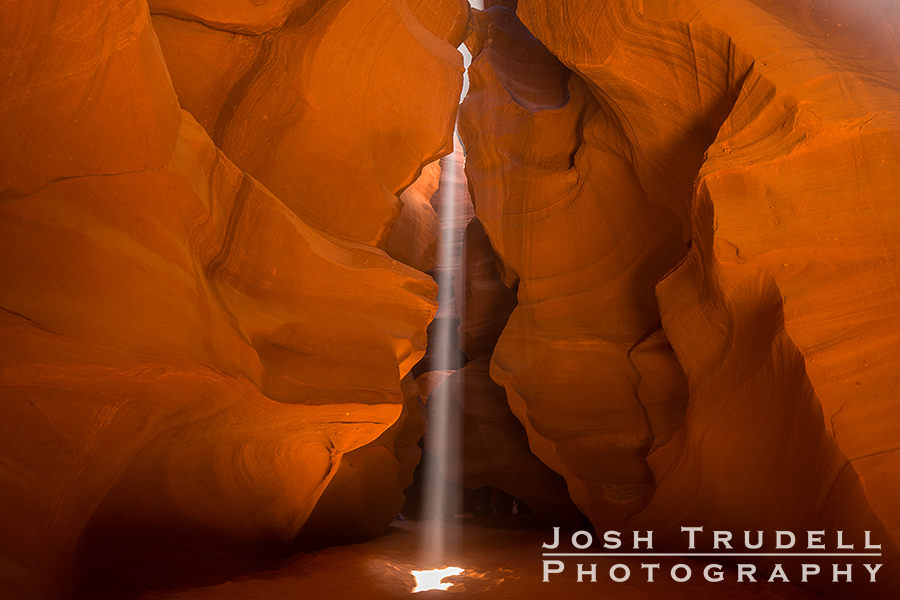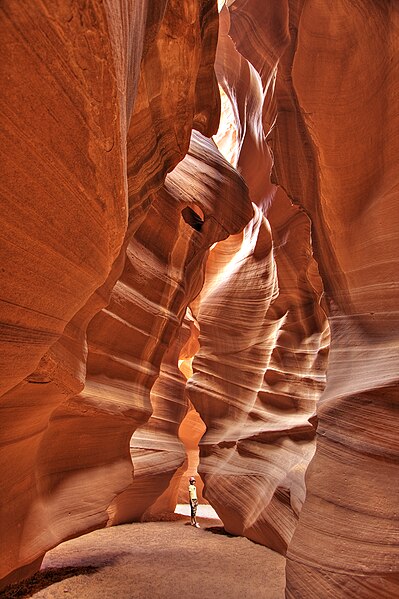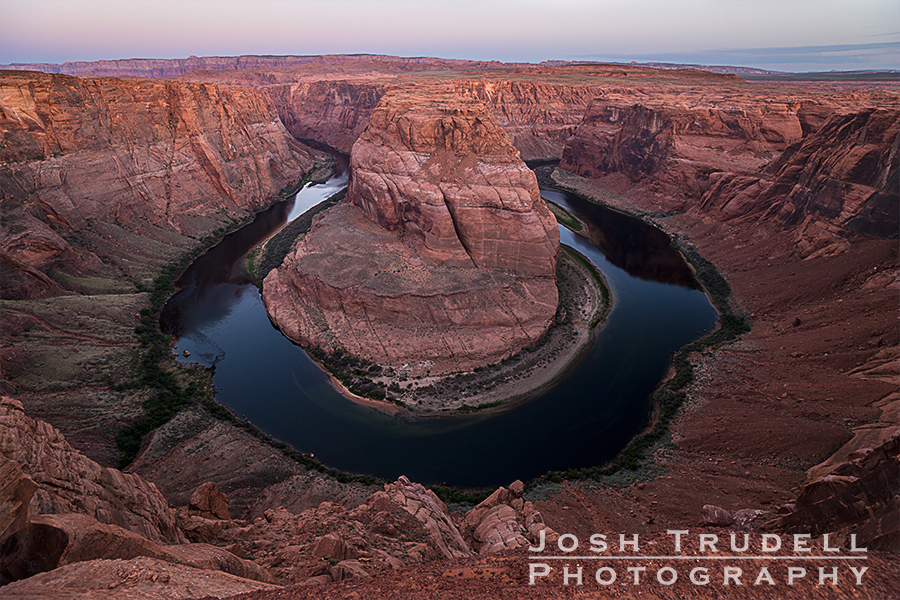Arizona & Utah, Day 2
We’re up with our friend O:DarkThirty again, heading out to Horseshoe Bend, one of the most recognizable canyons in the world.
It’s funny – in some areas, places like this would probably have ropes or fences keeping you from the edge.
There is nothing between you and the edge at Horseshoe Canyon. And it is a long way down – nearly 1000 feet - to the tiny boat landing on the inside of the curve where we saw people camping.
One of our tribe – I won’t embarrass him by calling him out by name – was more than a little nervous about being that close to the edge. I don’t blame him, either, but I had seen a shot like the one above of Horseshoe many times, and I wanted one of my own.
So I made an effort not to look to closely at the river at the bottom of the canyon, crept up to the edge, and shot.
I wasn’t the only one, either – thousands of dollars in camera gear was inches from hundreds of feet of flight as we lined the rim, photographer crows on our perches.
After the sun came up, we made our way back to town for breakfast. Page is a mid-sized town – Ian said there were 17 churches, but I didn’t get a chance to count them. As we drove through the center of town and past a high school, baseball players were dragging the field, red dust puffing up behind them.
After breakfast, we headed out to Lower Antelope Canyon. The parking lot is on the other side of the road from Upper Antelope Canyon.
In Upper Antelope, you walk straight into a cliff face cracked by the slot canyon. In Lower Antelope, you walk down some stone steps and small ladders to the canyon floor.
As our group waited for its turn to go down in the caves, we got a bit of a chuckle listening to the guide give people instructions on taking pictures in the canyon.
He repeatedly told people to use “Beach Mode” on their cameras, and it quickly became our catchphrase for the rest of the trip.
“Got that in focus?” “Yep – got it in Beach Mode. I’m good.”
Lower Antelope proved to be more narrow in spots than Upper Antelope – less than three feet wide in places, making for some bending and twisting.
The canyon walls were lighter and more colorful. Bracketing our exposures – shooting the same frame with multiple exposures - was important here to get the rich colors and shadows in detail.
Thanks to Ian, we hit the Keyhole – a hole in the rock façade that has a beam of light shine through it for about 15 minutes during the day – just in time to capture that. Ian played the part of Sandman, bringing the light into sharper focus.
As we progressed through the canyon, crowds were noticeably less than in Upper Antelope, but the narrow pathway made even a steady single-file stream seem busy.
We came to a steep, nearly vertical metal stairway/ladder, and then a switchback metal stairway to climb out, with about a 15 minute walk across sand back to the parking lot.
Post lunch, we packed up and headed east to Hunts Mesa in Monument Valley.
As we rolled into the valley, it felt like we were entering the domain of giants. Huge red monsters loomed over the landscape.
After a pit stop, we met our guide, Ray, who took us around Monument Valley and through Kayenta, AZ. (You can’t get to the mesa from the park by road…in fact, unless you’re hiking or ready for some off-roading, you can’t get there at all.)
Bull-rushing across dunes, with sand kicking up as high as the windows, there were a few white knuckle moments as Ray whipsawed the truck to keep it moving.
Once past the dunes, we did a slow crawl up the narrow trail to the mesa’s peak, just in time to catch the last few minutes of daylight.
It was short-lived, though – a blanket of clouds descended and took the glowing hills away. Unfazed, we channeled our inner Ansel Adams (with the help of a flask or two) and went for black and white moments.
Ray and his assistants were excellent campfire books, and we crashed early, hoping the clouds would clear off in the night.
Arizona and Utah, Day 1
 After far too much time, I’m finally getting around to recapping the five-day photo trip I took in May 2013 to Arizona and Utah.
After far too much time, I’m finally getting around to recapping the five-day photo trip I took in May 2013 to Arizona and Utah.
This area has always been high on my photography bucket list – when I drew up my first list, the glowing depths of Antelope Canyon was the first thing I wrote down.
I had a hard time giving myself permission to take the trip, though. Even though I was making some good money freelancing stories and photos for the local newspaper (on top of the Day Job), it seemed like an extravagance.
Talking it out with my wife helped me realize that not only could I go, I could take the next step and set up my own company, marketing outdoor recreation and travel stories with photography.
On New Year’s Eve, I was looking at various photo tours in the Arizona/Utah region when I came across Ian Whitehead. I had seen his site before when daydreaming about these trips, but now that it was more serious, I reached out to him to see what tours he had available.
Five days, four people, Antelope Canyon, Alstrom Point, Hunts Mesa/Monument Valley, and the parks around Moab. Perfect.
I might have pelted him with e-mails to the point of drowning, but he was very patient with me, advising me on all the gear I needed.
Before I knew it, it was early May, and I was flying in Flagstaff. We pick up the story at 0:DarkThirty…
Day 1: Sedona, Arizona-Page, Arizona Or, it would have been O:DarkThirty, but by the time the O finished yawning and it got to Dark, we were on the road and headed for Page, a two-hour-plus drive.
After a late night flight into Flagstaff and drive into Sedona the night before, it was a slightly sleepy me that got into Ian’s truck for the ride north with the three other photographers – Chris, Bob and Arnold.
With a breakfast stop for sugar and caffeine though, we were good to go.
One of the quirks about traveling through Arizona is the difference in times. I live in Central Time, and Arizona is on Mountain Time, but it doesn’t recognize Daylight Savings. Navajo Nation – the parts of three states that fall under the Native Americans - does support Daylight Savings Time, but Hopi Nation – a smaller state within Navajo Nation – does not.
Coordinate your timepieces. And your codpieces.
Our first day’s schedule was busy – Rattlesnake Canyon, Upper Antelope Canyon and Alstrom Point. We didn’t waste any time hustling up the road to Page, our headquarters for the next couple of nights.
Getting to Antelope Canyon itself can’t be done on your own – you need to hire a Navajo guide. We arrived at the wide spot in the road outside of Page where the tours start and transferred to a large truck.
The truck drove into a big, sandy wash for between one and two miles from the parking lot to our first stop – Rattlesnake Canyon.
Rattlesnake and Antelope canyons are what are known as slot canyons – narrow clefts in the rock that allow for thin beams of sunlight to slip down to the canyon floor, making for some elegant lighting and beautiful images.
Rattlesnake was a good introduction to photographing these – there were virtually no crowds (or room for any crowds). Climbing up a couple of ladders to the shallow slot, we squeezed our way through the narrow passage one at a time, trying to protect lenses and tripods from the walls and each other.
I was using a Sony tripod at this point, but for this canyon, I’d probably use a Gorillapod to save on space.
After about an hour, we drove the rest of the way down the wash to Upper Antelope Canyon – a photographer’s mecca.
There are good things and bad things about meccas – they are wonderful places, and they draw armies of people.
Surrounded by people toting iPods, iPads, point-and-shoots, DSLRS of every make and model, large-format cameras - probably even pinhole cameras - we walked into Upper Antelope Canyon.
The Navajo guides do a fairly good job keeping the groups separated – only rarely did someone from another group stumble into my frame. This was a place where Ian definitely earned his keep, too – getting his group to the right places for dynamic frames, offering exposure tips and making sure we weren’t rushed and/or blocking traffic.
It was tight quarters, though – there are areas where photographers were lined up in murderer’s rows, tripod to tripod with the person next to them.
--SPOILER ALERT-- I’m going to spill a secret here – those beautiful light beams that filter down, framed in swirling dust? That dust doesn’t get there by itself, folks. The guides spend a lot of time lining people up in good photography spots, then dashing over to the side of the lightbeam (out of the frame, usually) and tossing handfuls of sand into the light as we snap away. --END SPOILER--
After two hours, we found our way out, cameras full of cool images. Also noticeably dehydrated – it wasn’t baking hot, but the moisture does disappear from the body noticeably out there.
We had a needed siesta, then headed out to Alstrom Point for sunset. Alstrom Point is a remote spot that requires a four-wheel-drive with sturdy tires to get to.
Our four-wheel-drive was lacking in sturdy tires, popping a rear wheel about halfway there. Ian again came to the rescue, changing the tire and getting us out to the point in plenty of time for sunset.
The point overlooks Lake Powell and Gunsight Butte – with just the five of us spread out along the point and no service, it was easy to feel like we were on a different planet.
After sunset, we crawled back into town, exhausted at the end of a long day. We shoveled in food at a local steakhouse and tried to catch some sleep, despite the atrocious karaoke/cover band combination polluting the air from across the street. DAY 2: Into the Canyon and Up to the Mesa
Daydreaming about canyon hunting

Part of surviving the grind of schoolwork/regular work/freelance work is finding ways to pick up little bursts of inspiration and happiness. For me, that can range from listening to the Red Sox win a game to getting out with my camera and taking pictures of something new.
Another source of inspiration is seeing what other photographers are working on. My fascination for the last couple of weeks has been a blog called A Curious Endeavor.
Written by Kate Lockhart, she's an accomplished photographer and a good writer. Recently, she’s been on a road trip through the Southwest, stopping at some of photography’s holy grails: Monument Valley, the Grand Canyon, and my personal favorites, Upper and Lower Antelope Canyon.
These canyons, which are nestled against the Utah border outside of Page, Arizona, are the source of some of the most famous photographs ever taken. She does a great job capturing the magic of these spots, and her writing is very helpful to photographers planning to visit these places - it’s filled with tips about what to watch for and how to reach certain spots.
One of my photography dreams is to travel the Southwest on a road trip like that. My only taste of it so far has been an afternoon at the Grand Canyon, and it’s only whetted my appetite.
Bring on that homework – the canyons await!







